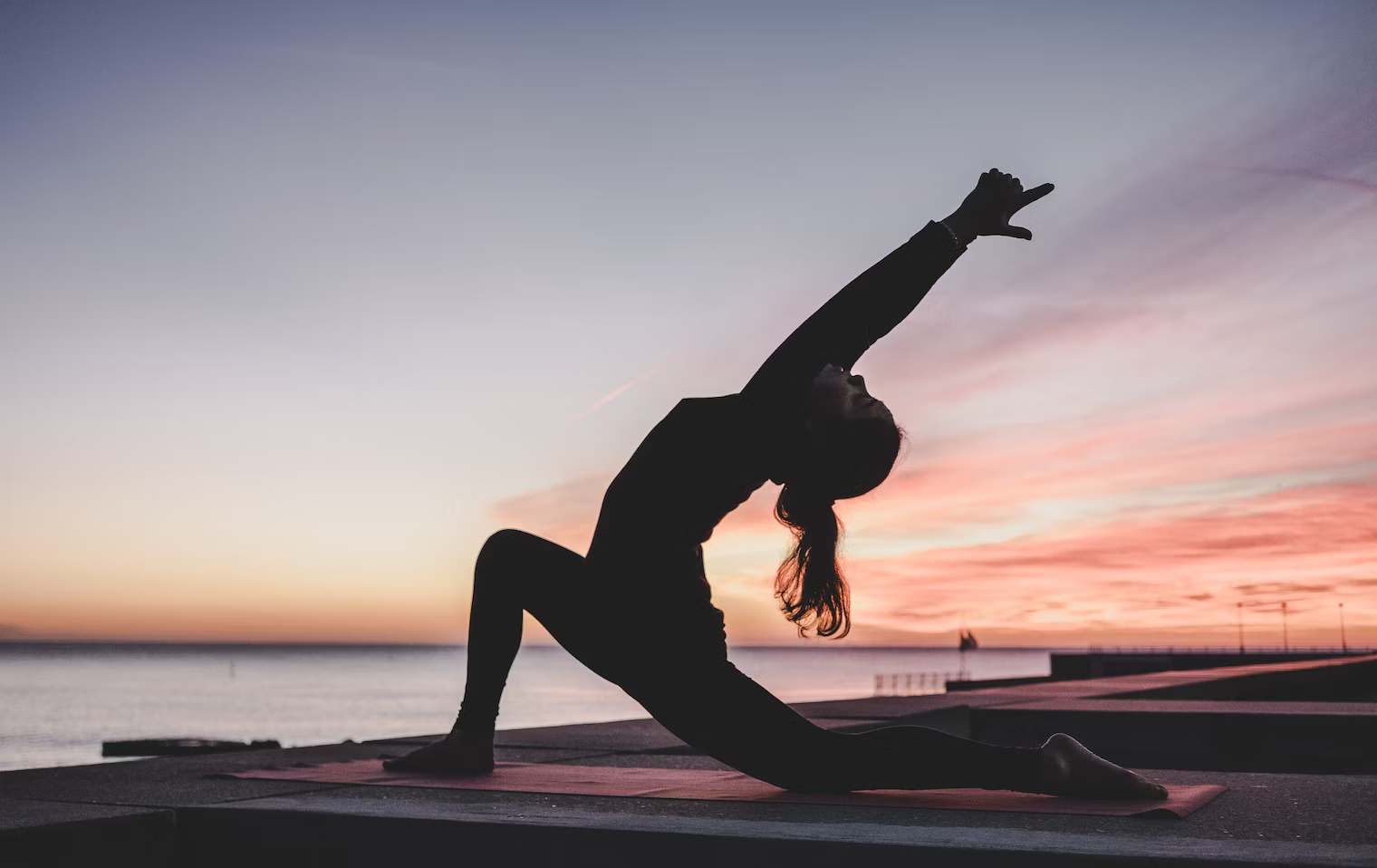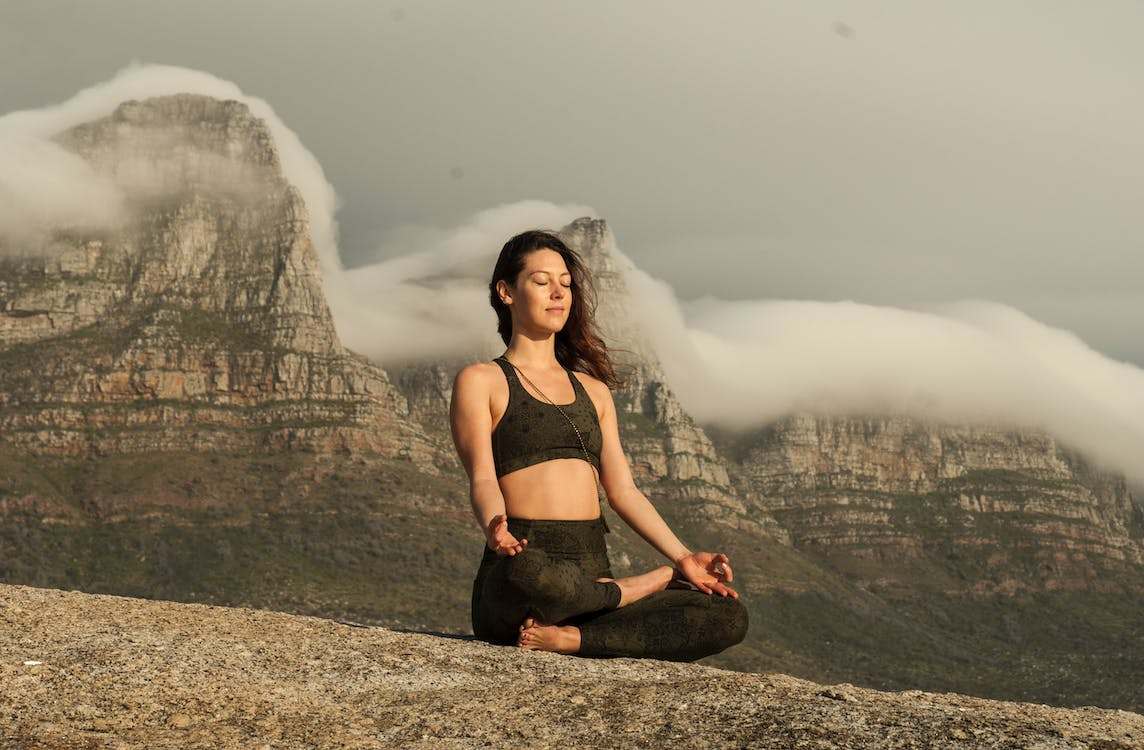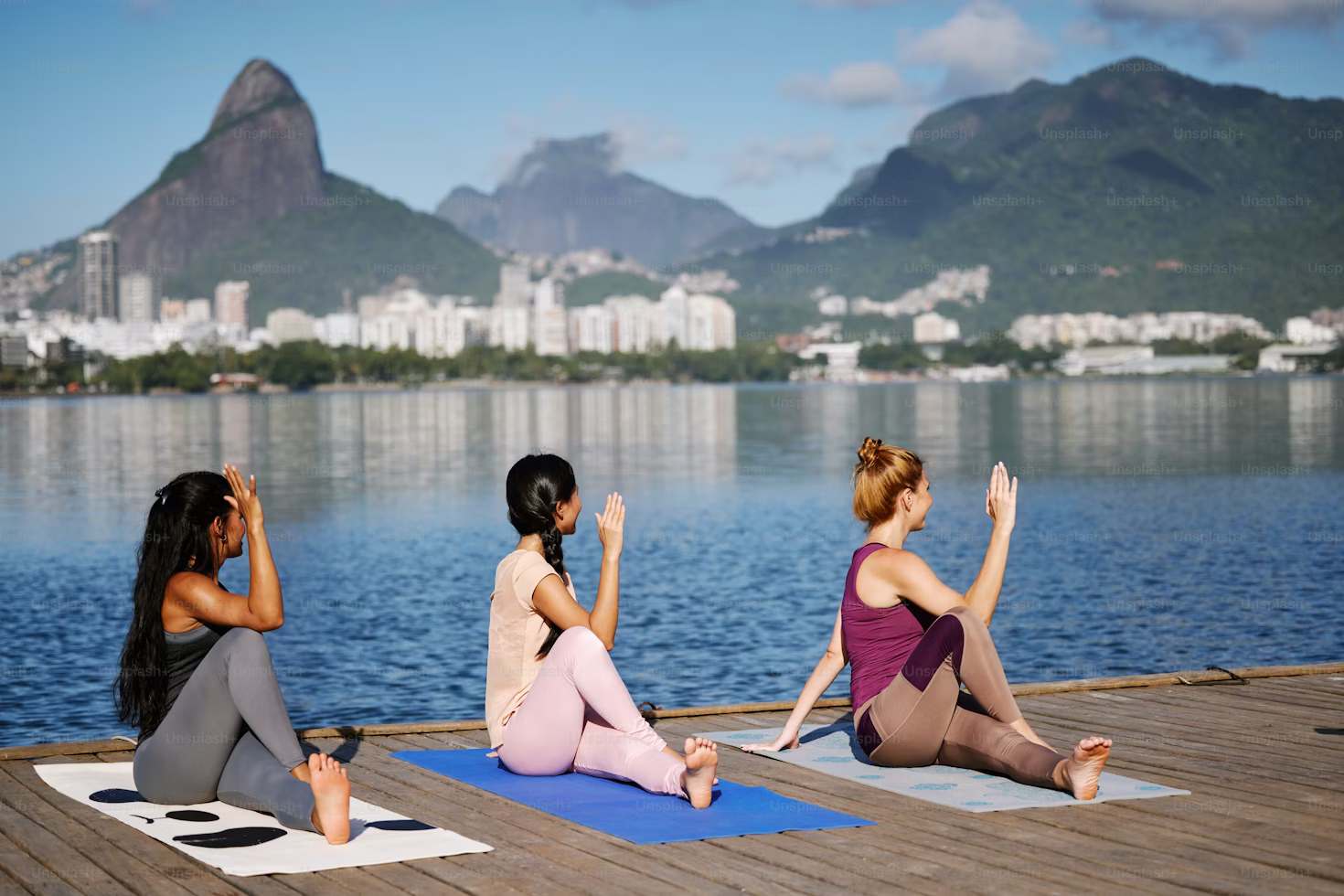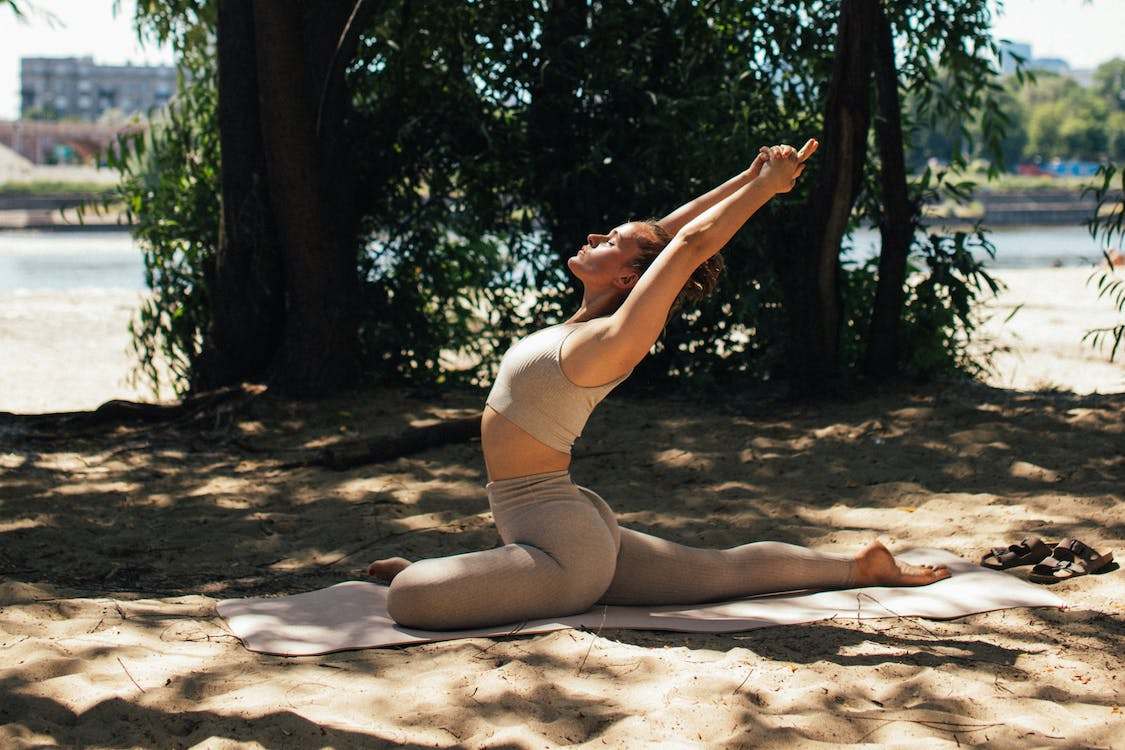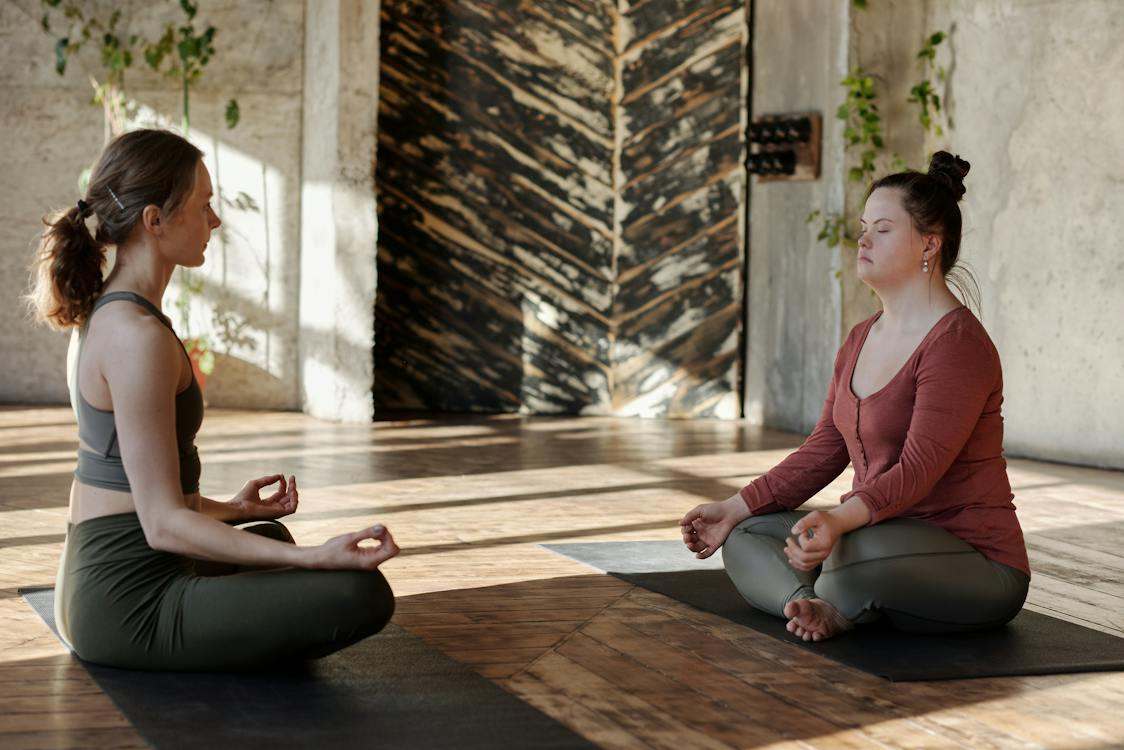Yoga – an old-age discipline with roots dating back thousands of years, is a holistic practice that seamlessly intertwines physical, mental, and spiritual dimensions. (1) Centered around the fundamental principles of controlled breathing and purposeful postures, yoga is a comprehensive approach to enhancing mental well-being and physical vitality. Originating in the mystical landscapes of ancient India, this ancient practice has transcended cultural boundaries and found resonance across the globe. In this exploration, we delve into the origins of yoga, dissect its distinctive components of breathwork and postures, and examine the diverse ways in which it has been embraced worldwide. Join us on a journey to unravel the timeless appeal, benefits, and universal adaptability of yoga.
History of Yoga
The history of yoga is characterized by numerous realms of obscurity and uncertainty, largely attributed to its reliance on oral transmission of sacred texts and the clandestine nature of its teachings. The initial writings on yoga were inscribed on delicate palm leaves, susceptible to damage, destruction, or loss. While the development of yoga can be traced back over 5,000 years, some scholars propose that its origins may extend even further, reaching a staggering age of possibly 10,000 years. (2) This extensive and intricate history of yoga can be categorized into four distinct periods marked by innovation, practice, and development.
Pre-Classical Yoga
The origins of Yoga trace back to the ancient Indus-Sarasvati civilization in Northern India, flourishing over 5,000 years ago. The term “yoga” made its inaugural appearance in the oldest sacred texts, the Rig Veda. These texts, serving as a repository of songs, mantras, and rituals for Brahman priests, were the foundation of early yogic practices. The refinement and evolution of Yoga unfolded gradually, guided by the insights of Brahman priests and Rishis, mystic seers. Their extensive documentation of practices and beliefs found culmination in the Upanishads, an extensive compilation comprising over 200 scriptures. Among these, the Bhagavad-Gîtâ, composed around 500 B.C.E., stands as the most celebrated Yogic scripture. (2) The Upanishads took the concept of ritual sacrifice from the Vedas and internalized it, advocating the sacrifice of the ego through self-knowledge, action, and wisdom.
Classical Yoga
In the preceding pre-classical era, yoga existed as a diverse amalgamation of varied ideas, beliefs, and techniques, often marked by conflicts and contradictions. The Classical period, however, is characterized by the emergence of Patanjali’s Yoga-Sûtras, representing the inaugural systematic exposition of yoga. Penned during the second century, this text delineates the principles of Raja Yoga, frequently referred to as “classical yoga.” Patanjali meticulously structured the practice of yoga into an “eight-limbed path,” outlining the sequential steps and stages leading towards the attainment of Samadhi or enlightenment. Often hailed as the father of yoga, Patanjali’s Yoga-Sûtras continue to exert a profound influence on most contemporary styles of yoga.
Post-Classical Yoga
Several centuries subsequent to Patanjali’s era, yoga visionaries devised a set of practices intended to revitalize the body and extend life. Rejecting the doctrines of the ancient Vedas, they embraced the physical body as a conduit for attaining enlightenment. Out of this divergence emerged Tantra Yoga, featuring radical techniques designed to purify the body and mind, unraveling the ties that tether us to our physical existence. This exploration of the intricate interplay between the physical and spiritual realms, along with a focus on body-centered practices, ultimately gave rise to what is predominantly recognized as yoga in the Western world: Hatha Yoga.
Modern Period
In the late 1800s and early 1900s, a transformative phase in the history of yoga unfolded as revered yoga masters embarked on journeys to the West, capturing attention and garnering followers. A pivotal moment occurred at the 1893 Parliament of Religions in Chicago when Swami Vivekananda captivated attendees with his enlightening lectures on yoga and the universal essence embedded in the world’s diverse religions. The 1920s and 30s witnessed a robust promotion of Hatha Yoga in India, spearheaded by luminaries such as T. Krishnamacharya and Swami Sivananda, both dedicated practitioners of Hatha Yoga. Krishnamacharya established the inaugural Hatha Yoga school in Mysore in 1924, while in 1936, Sivananda founded the Divine Life Society on the sacred banks of the Ganges River. (3) Krishnamacharya’s legacy endured through three notable students—B.K.S. Iyengar, T.K.V. Desikachar, and Pattabhi Jois—each contributing to the proliferation and popularity of Hatha Yoga. Sivananda, a prolific author, penned over 200 books on yoga and left an indelible mark by founding nine ashrams and numerous yoga centers worldwide.
The Six Branches of Yoga
The fundamental philosophy of yoga revolves around the integration of the mind, body, and spirit. Yoga encompasses six branches, with each branch embodying a distinct focus and a unique set of characteristics.
- Hatha Yoga: Serving as the physical and mental facet of yoga, Hatha Yoga endeavors to prepare and optimize both the body and mind. This branch places a strong emphasis on the harmonization of physical postures (asanas), breath control (pranayama), and mental focus to achieve a balanced and attuned state of well-being. The practice of Hatha Yoga involves a series of physical poses and controlled breathing techniques, fostering a holistic approach to enhance physical strength, flexibility, and mental clarity. Through the intentional synchronization of body movements and breath, practitioners seek not only physical vitality but also a profound sense of mental equilibrium, making Hatha Yoga a foundational and comprehensive pathway to overall wellness.
- Karma Yoga: Representing the path of selfless service, Karma Yoga is dedicated to fostering a future devoid of negativity and selfishness. This branch of yoga is grounded in the belief that actions, when performed with a spirit of selflessness and without attachment to the fruits of those actions, contribute to the collective well-being of society. Practitioners of Karma Yoga strive to engage in actions that are morally upright and beneficial to others, aiming to create a positive impact on the world. By aligning one’s actions with a sense of duty and compassion, Karma Yoga not only seeks personal spiritual growth but also envisions a harmonious and altruistic future for humanity, transcending individual interests for the greater good.
- Jnana Yoga: Serving as the path of wisdom, Jnana Yoga is dedicated to scholarly pursuits and the development of intellect through rigorous study. This branch of yoga places a profound emphasis on cultivating knowledge and discernment as a means to attain spiritual enlightenment. Practitioners of Jnana Yoga engage in deep philosophical inquiry, contemplation, and the pursuit of self-awareness. The journey involves exploring the nature of reality, understanding the self, and unraveling the layers of consciousness. By delving into sacred texts, philosophical discourse, and introspective practices, individuals on the path of Jnana Yoga seek to transcend the limitations of the intellect and achieve a higher state of consciousness. This intellectual and contemplative approach distinguishes Jnana Yoga as a transformative quest for profound wisdom and self-realization.
- Raja Yoga: This branch of yoga centers around meditation and the meticulous adherence to a set of disciplined steps known as the eight limbs of yoga. Raja Yoga, often referred to as the “royal path,” places a primary focus on the cultivation of mental and spiritual discipline. The eight limbs, as outlined by Patanjali in the Yoga Sutras, encompass ethical principles (yamas and niyamas), physical postures (asanas), breath control (pranayama), withdrawal of the senses (pratyahara), concentration (dharana), meditation (dhyana), and ultimate absorption or enlightenment (samadhi). (4) By integrating meditation into daily life and adhering to these disciplinary steps, individuals aim to achieve inner peace, mental clarity, and spiritual realization. Raja Yoga serves as a comprehensive and structured approach to self-mastery, guiding practitioners toward a profound understanding of the mind and its connection to the spiritual realm.
- Bhakti Yoga: This branch of yoga is dedicated to establishing the path of devotion, providing a positive avenue to channel emotions and fostering the cultivation of acceptance and tolerance. Bhakti Yoga revolves around the sincere and unwavering devotion to a higher power, whether it be a personal deity, the divine, or a universal force. Practitioners of Bhakti Yoga seek to cultivate a deep and loving connection with the divine through devotional practices such as prayer, worship, chanting, and rituals. The essence of Bhakti Yoga lies in the transformative power of love and surrender. By redirecting emotions and cultivating a profound sense of devotion, practitioners aim to transcend the ego and experience a sense of unity with the divine. This path emphasizes the positive expression of emotions, encouraging individuals to embrace qualities such as love, compassion, and tolerance in their relationships with others.
- Tantra Yoga: Representing the pathway of ritual, ceremony, and the consummation of relationships, Tantra Yoga is a unique branch that encompasses both spiritual and worldly aspects. In Tantra, the physical and spiritual dimensions of life are seen as interconnected, and the practice seeks to harmonize and elevate both. Unlike some popular misconceptions, Tantra goes beyond the scope of intimacy and encompasses a diverse range of practices, including rituals, mantra chanting, and meditation. Tantra Yoga views the body, mind, and spirit as instruments for spiritual evolution, and practitioners aim to attain a heightened state of consciousness. The focus is on embracing all aspects of life, both the positive and challenging, as opportunities for spiritual growth.
11 Different Types of Yoga
- Ashtanga Yoga– rooted in ancient teachings, gained popularity in the 1970s. It follows a dynamic approach, applying a set sequence of poses synchronized with breath, emphasizing strength, flexibility, and endurance. Developed by Pattabhi Jois, it is known for its disciplined and structured practice.
- Kripalu Yoga – this form of yoga guides practitioners to understand, accept, and learn from their bodies. Rooted in self-inquiry, Kripalu encourages students to discover their own practice levels through introspection. Classes typically commence with breathing exercises and gentle stretches, leading into a sequence of individual poses and concluding with a final relaxation period.
- Bikram Yoga – commonly referred to as hot yoga, distinguishes itself by its practice environment: rooms intentionally heated to approximately 105°F with 40% humidity. This elevated temperature is believed to promote increased flexibility and detoxification through sweating. The sequence of Bikram Yoga involves 26 poses and two specific breathing exercises, performed in a systematic and structured manner.
- Power Yoga – originating in the late 1980s, Power Yoga is an active and athletic form developed by practitioners, drawing inspiration from the traditional Ashtanga system. This style emphasizes strength, flexibility, and dynamic movements in a physically challenging practice.
- Iyengar Yoga – centered on precise alignment in each pose, Iyengar Yoga employs an array of props, including blocks, blankets, straps, chairs, and bolsters. This practice emphasizes the importance of achieving correct alignment through the support of these props, promoting precision and awareness in each yoga posture.
- Kundalini Yoga – this meditation system focuses on releasing pent-up energy. In a Kundalini yoga class, chanting initiates the session, which concludes with singing. The practice incorporates asana, pranayama, and meditation to generate specific outcomes throughout the session.
- Restorative Yoga: A serene and relaxing approach to yoga, Restorative Yoga involves spending a class in four or five simple poses. Utilizing props like blankets and bolsters, practitioners can comfortably sink into deep relaxation without exerting effort to hold the poses. This method promotes rejuvenation and stress relief, offering a gentle and supportive practice for both the body and mind.
- Sivananda – built upon a five-point philosophy, this system asserts that proper breathing, relaxation, diet, exercise, and positive thinking collectively form the basis of a healthy yogic lifestyle. Sivananda practitioners engage in 12 fundamental asanas, incorporating Sun Salutations at the beginning and concluding with Savasana for a comprehensive and balanced yoga practice.
- Viniyoga – emphasizing form over function, breath and adaptation, repetition and holding, Viniyoga is a yoga style that delves into the art and science of sequencing. This approach tailors the practice to individual needs, allowing for a personalized and adaptable yoga experience.
- Yin Yoga – centered on holding passive poses for extended durations, Yin Yoga directs its attention to the deep tissues, ligaments, joints, bones, and fascia. This style of yoga encourages a patient and introspective practice, fostering flexibility and mobility in the often-neglected connective tissues of the body.
- Prenatal Yoga – tailored to the unique needs of pregnant individuals, Prenatal Yoga incorporates poses specifically designed with pregnancy in mind. This style of yoga not only supports health during pregnancy but also assists in postpartum recovery, aiding individuals in regaining physical fitness after giving birth.
7 Health Benefits of Yoga and How to Achieve It
Yoga provides health benefits for individuals across various age groups, addressing both physical and mental well-being. Additionally, for those navigating illness, post-surgery recovery, or managing chronic conditions, integrating yoga into their treatment regimen can play a crucial role and potentially expedite the healing process. (5)
- Reduces Stress: Yoga serves as an effective tool for stress management. Supported by scientific evidence from the National Institutes of Health, yoga is shown to positively impact various aspects of well-being, including stress management, mental health, mindfulness, healthy eating, weight loss, and the quality of sleep. (5) An accessible pose to experience relaxation is the Corpse Pose (Savasana): lie down with limbs gently stretched away from the body, palms facing up, and focus on deep breathing while attempting to clear the mind. This pose can be held for 5 to 15 minutes, providing a rejuvenating and calming effect.
- Enhanced Strength and Flexibility: Yoga enhances strength, balance, and flexibility through deliberate movements and controlled breathing, promoting increased blood flow and muscle warmth. Holding yoga poses contributes to strength building. A suggested pose to experience these benefits is the Tree Pose. Stand on one foot and bring the other foot to rest on your calf or above the knee, avoiding placement on the knee itself. Maintaining focus on a single point in front of you, attempt to balance for one minute, engaging core muscles and refining both physical and mental steadiness.
- Improved Heart Health: Yoga proves beneficial for heart health by potentially reducing stress levels and overall body inflammation through regular practice. Addressing factors linked to heart disease, such as high blood pressure and excess weight, can be part of the positive impact of yoga. (5) A recommended pose for fostering heart health is the Downward Dog Pose. Begin on all fours, tuck your toes, and lift your sitting bones upward, forming a triangle shape. Maintain a slight bend in your knees while elongating your spine and tailbone, contributing to both physical and cardiovascular well-being.
- Eliminates Back Pain: Yoga proves to be as effective as basic stretching in providing relief from lower back pain and enhancing mobility, according to the American College of Physicians, which recommends yoga as a primary treatment for chronic low back pain. (5) A suggested pose to address back pain is the Cat-Cow Pose. Begin on all fours, aligning your palms under your shoulders and knees under your hips. Inhale as your stomach drops toward the floor, and then exhale, drawing your navel towards your spine, creating an arch in your back reminiscent of a cat stretching. This simple yet impactful pose can contribute to alleviating back pain and improving spinal flexibility.
- Better Sleep Quality: Engaging in a consistent bedtime yoga routine can significantly contribute to relaxation and improved sleep quality. Yoga prepares the mind and body for restful sleep, creating a conducive mindset for falling asleep and staying asleep. An effective pose for this purpose is the Legs-Up-the-Wall Pose. Sit with your left side against a wall, turn gently to the right, and lift your legs to rest against the wall, keeping your back on the floor and sitting bones close to the wall. Remaining in this position for 5 to 15 minutes offers a calming and restorative experience, promoting relaxation before bedtime.
- Brighter Moods: Embarking on a routine of practicing yoga can result in enhanced mental and physical energy, heightened alertness, increased enthusiasm, and a reduction in negative feelings. The cumulative effects of yoga often lead to a brighter mood and an overall sense of well-being, emphasizing its potential to bring about a positive and energizing impact on both the mind and body.
- Strong Connection with Community: Engaging in yoga not only fosters a connection with one’s personal practice but also creates ties within a supportive community. Participation in yoga classes serves as a means to alleviate loneliness, offering a setting for group healing and mutual support. Even in one-on-one sessions, the experience is tailored to acknowledge the uniqueness of the individual, providing a platform for active listening and collaborative creation of a personalized yoga plan. This communal aspect of yoga contributes significantly to reducing feelings of isolation and reinforces the sense of connection within the practice.
Conclusion
Yoga is an ancient practice, that has evolved over time, with modern iterations placing a strong emphasis on poses aimed at fostering inner peace and physical vitality. While ancient yoga prioritized mental focus and spiritual expansion over fitness, contemporary practitioners can choose from a variety of yoga styles tailored to their expectations and physical abilities. Regardless of the chosen style, engaging in yoga has the potential to contribute to a balanced and active lifestyle, showcasing the enduring relevance and adaptability of this time-honored practice.
